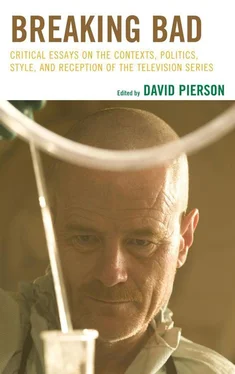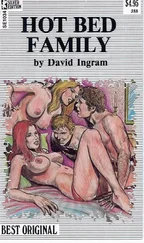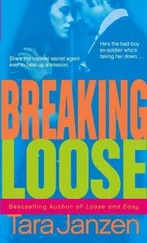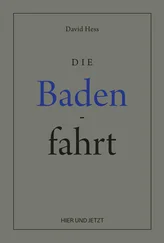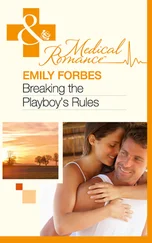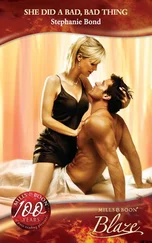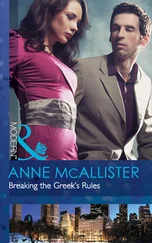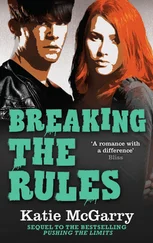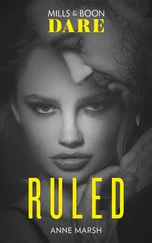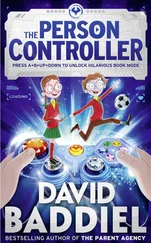But there is a further element that adds to the text’s indeterminacy: at the end of the episode—the season’s finale—Jesse faces Gale with a gun, we hear a gunshot, but we do not see Gale being hit. Interestingly, many viewers refused to accept that Jesse had actually killed Gale—an eventuality that producer Vince Gilligan had not anticipated. [24] “Gilligan’s intention with the scene was to have Jesse hit his target. But viewers found it so hard to believe that Paul’s sensitive, soulful character could commit cold-blooded murder—debates raged in fan forums—that Gilligan reconsidered, opening the season-four writers’ room ‘with a long and spirited discussion of whether we should actually have Aaron go through with it.’ Paul’s performance was that powerful” (Romano 2011, par. 19).
The point is that identification with Walt and Jesse, whom viewers struggle to think of as cold-blooded killers, induced viewers to infer conclusions that, to paraphrase Bunia (2010), are not explicitly conveyed by a representation. What I argue is that the condition for this (mis)interpretation is not limited to Gale’s implicit death but is also due to the role that music plays in enticing and puzzling viewers at the same time. That is, by implying that (fictional) reality is more complicated than it may appear at first sight (and at first listen), this sequence demands an interpretive effort that breaches the confines of the text to involve the viewer in the construction of an expanded diegesis. In this way, the producerly text becomes a platform for a selective application of moral codes in order to maintain cognitive consistency with character disposition or, alternatively, an opportunity for monitoring characters’ moral behavior—a task that may require, once again, a significant expenditure of cognitive resources and the capacity to cope with cognitive dissonance. Moreover, the chance to discuss this expanded diegetic space with others can increase viewing pleasure, making the producerly text a collective rather than an individual endeavor.
Not only is music of central importance in Breaking Bad , it also plays multi-dimensional roles in the series, thus affecting character liking and mediating identification processes. The need to maintain bonding (especially, but not necessarily only) with Walt throughout the series, or, in other words, to keep viewers interested enough to watch each new episode—an essential feature of serial drama—is continuously challenged by his becoming involved in actions that viewers may well find morally repugnant. In fact, the dissonance between the viewer’s moral code and Walt’s troubling wrongdoings can impact negatively on identification processes. To obviate this, Breaking Bad employs various strategies that allow for temporary shifts in identification while also using more subtle techniques that simultaneously prompt identification and detachment, engaging the spectator in Walt’s concerns through emotional affinities, while glossing over the consequences of his actions for society at large.
The ambivalence of identification processes in Breaking Bad implies that liquidity is not just an option but a condition that viewers have to negotiate throughout the series. This is because we realize that there is no higher morality justifying Walt’s efforts to defend his drug empire, just as there is no grand narrative to make sense of his initial impasse. Instead, viewers are faced with the deterioration of social bonds as a structural condition of late modernity—viewers share this condition with Walt, who experiences it on screen, and around this similarity, identification, albeit unsteadily, is built.
Bandura, Albert. “Selective Moral Disengagement in the Exercise of Moral Agency.” Journal of Moral Education . 31(2) (2002): 101-119.
Bauman, Zygmunt. Liquid Modernity . Cambridge and Malden, MA: Polity Press, 2000.
———. Does Ethics Have a Chance in a World of Consumers? Cambridge and London: Harvard University Press, 2008.
Booker, M. Keith. Postmodern Hollywood: What’s New in Film and Why It Makes Us Feel So Strange . Westport and London: Praeger Publishers, 2007.
Brown, Royal S. Overtones and Undertones: Reading Film Music . Berkeley: University of California Press, 1994.
Bunia, Remigius. “Diegesis and Representation: Beyond the Fictional World, on the Margins of Story and Narrative.” Poetics Today . 31:4. (2010): 679-720.
Ferrell, Jeff. Crimes of Style: Urban Graffiti and the Politics of Criminality . Boston: Northeastern University Press, 1996.
———. “Cultural criminology.” Annual Review of Sociology . 25. (1999): 395-418.
Ferrell, Jeff, Dragan Milovanovic and Stephen Lyng. “Edgework, Media Practices, and the Elongation of Meaning.” Theoretical Criminology. 5:2. (2001): 177-202.
Fiske, John. Television Culture . 2nd ed. Abingdon and New York: Routledge, 2010.
Goodwin, Andrew. “Fatal Distractions: MTV Meets Postmodern Theory.” In Sound and Vision: The Music Video Reader, edited by Simon Frith, Andrew Goodwin and Lawrence Grossberg. 37-56. London: Routledge, 1993.
Gorbman, Claudia. Unheard Melodies: Narrative Film Music . Bloomington and Indianapolis: Indiana University Press, 1987.
Kassabian, Anahid. Hearing Film: Tracking Identifications in Contemporary Hollywood Film Music . New York and London: Routledge, 2001.
Katz, Jack. Seductions of Crime . New York: Basic Books, 1988.
Lannin, Steve and Matthew Caley, eds. Pop Fiction: The Song in Cinema . Bristol and Portland: Intellect, 2005.
MacRory, Pauline. “Excusing the Violence of Hollywood Women: Music in Nikita and Point of No Return. ” Screen . 40:1. (1999): 51-65.
Mundy, John. Popular Music on Screen: From Hollywood Musical to Music Video . Manchester: Manchester University Press, 1999.
Nardi, Carlo. “Library Music: Technology, Copyright and Authorship.” In Issues in Music Research: Copyright, Power And Transnational Musical Processes, edited by Salwa El-Shawan Castelo-Branco et al., 73-83. Lisbon: SIBE, 2012.
Powrie, Phil and Robynn Stilwell, eds. Changing Tunes: The Use of Pre-existing Music in Film . Aldershot and Burlington: Ashgate, 2006.
Presdee, Mike. Cultural Criminology and the Carnival of Crime . London and New York: Routledge, 2000.
Quartetto Cetra. “Crapapelada.” B-side of “Peppone il calciatore.” Cetra. AA 421. Vinyl Single Record. 1945.
Ramírez-Pimienta, Juan Carlos. “Del Corrido de Narcotráfico al Narcocorrido: Orígenes y Desarrollo del Canto a los Traficantes.” Studies in Latin American Popular Culture . XXIII. (2004): 21-41.
———. Cantar a Los Narcos: Voces y Versos del Narcocorrido . Mexico City: Editorial Planeta, 2011.
Raney, Arthur A. “Expanding Disposition Theory: Reconsidering Character Liking, Moral Evaluations, and Enjoyment.” Communication Theory . 14:4. (2004): 348-369.
Ray, Austin L. “The Chemistry Behind the Music in ‘Breaking Bad’.” MTV Hive . 16 July 2012. http://www.mtvhive.com/2012/07/16/breaking-bad-music/.
Romano, Andrew. “The Most Dangerous Show on Television.” Newsweek. 158:2. 4 July, 2011. 58-63.
Romney, Jonathan and Adrian Wootton, eds. Celluloid Jukebox: Popular Music and the Movies since the 50 s . London: BFI, 1995.
Shumway, David R. “Rock ’n’ Roll Sound Tracks and the Production of Nostalgia.” Cinema Journal . 38:2. (1999): 36-51.
Simonett, Helena. “Narcocorridos: An Emerging Micromusic of Nuevo L.A.” Ethnomusicology . 45:2. (2001): 315-337.
Читать дальше
